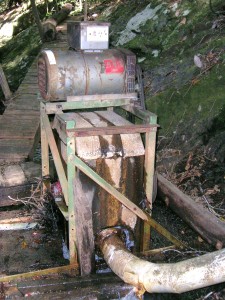Possum Valley Power Supply
Paul designed and built the power system and is pleased to show it to you. Come and find me, probably at the homestead, for a conducted tour.
Overview
Possum Valley electricity supply is a hybrid system with inputs from both hydro and solar. This is in the hope that when the hydro power dwindles in the dry season, the sun will shine and the solar input will be at a maximum. In the wet season, when the cloudy weather reduces solar input, the hydro will be at maximum. The maximum input from hydro is about 1800W and from solar about 2000W. However, solar is only for a few hours a day and dependent on cloud cover and hydro is 24/7 regardless of weather.
The hydro power is generated by a homemade Pelton wheel turning about 450 rpm with a belt drive with 3/1 increase in speed to 1500 rpm using a belt drive, to a 240V AC 4 pole generator. It is transmitted to the homestead where all the clever stuff is, and put into a battery bank of 12 by 2V 750 amp hour batteries at 24V DC.
The solar power is generated at 24V DC and fed directly to the batteries via a Plasmatronics PL40 solar controller.
Your eyes may be glazing over by now, so for all but techheads, skip the figures and read the text.
The battery chargers are programmed to charge according to battery voltage from boost to float to avoid overcharging.
There are advantages to putting the power into batteries rather than using direct from the hydro. Using hydro direct, peak power usage is limited to a fixed amount, which if exceeded, will lead to a ‘brown out’ and falling voltage which may damage some equipment. Power consumption is highly erratic with fridges, washing machine, lights etc going on and off all the time. Electricity stored in batteries can meet these short term peaks. Stored power is also useful to start electric motors which can require 10 times their rated power to kick off in the first second. The main power inverter provides a pure sine wave at 3000w continuous, 4500W for up to 20 mins, and 9000W in surge.
In its first form, the power supply went online in 1983.
Performance
The hydro can produce about 1800W or so at full power or about about 43 kWhrs per day. That is for about 8 months of the year when there is plenty of water in the creek. This dwindles to about 400W or 9.6 kWhrs at the driest times. In 25 years of operation, it has been shut down twice due to lack of water. Once for one week and once for 3 weeks. These were at the historically driest times in the area.
Most of the year there is a considerable surplus of power. In Sept, Oct. Nov and sometimes Dec (depending if the storms come), there may be temporary shortfalls and the solar panels do their bit. In the drier months, I would appreciate guests using normal economy measures such as switching off the lights in unoccupied rooms etc, and to check with Paul about plugging in any high power devices you may have brought. Devices like laptops take negligible power.
Solar
There are 12 by 90W, and 18 by 60W panels on the roof of the homestead that can produce a maximum of about 2000W at peak. Possum Valley is about the worst place in Australia for solar panels because of the cloud cover, but in the dry season when the creek is at minimum, they are likely to be at maximum output and doing some of the heavy lifting.
Inverter
The inverter takes the 24V DC from the battery bank and converts back to the normal 240V AC domestic supply voltage. It is a Latronics pure sine wave 3000W inverter that can handle 4200W for about 20 mins and 9500W for a short time for surge. Generally the frequency and voltage control is better than the mains supply. It is robust enough to easily handle my little welder.
RAPS
The latest equipment update was purchased under the Qld gov ‘Remote Area Power Scheme’, which offered a 75% rebate on equipment. I call that an offer I couldn’t refuse.
What am I stealing?
It is a universal fact that energy cannot be created or destroyed, but it can be very easily be transformed from one kind to another. My body runs on chemical energy in food that I convert to mechanical and heat energy. My fridge runs on electrical energy. So I am extracting energy from the environment. Water (mass) going to a lower energy state in a gravity field provides pressure at the nozzle, which accelerates the water giving it kinetic energy, which hits the turbine and converts to mechanical energy, which drives a generator which converts to electrical energy which I store in batteries (chemical energy).
So where would that energy have gone if I hadn’t extracted it? Mostly as heat. The water tumbling over the rocks would have heated the water by friction. A tiny bit as sound. It has been measured that the water at the bottom of a waterfall is warmer by the tiniest fraction of a degree, but is so hard to measure even with a huge waterfall.
